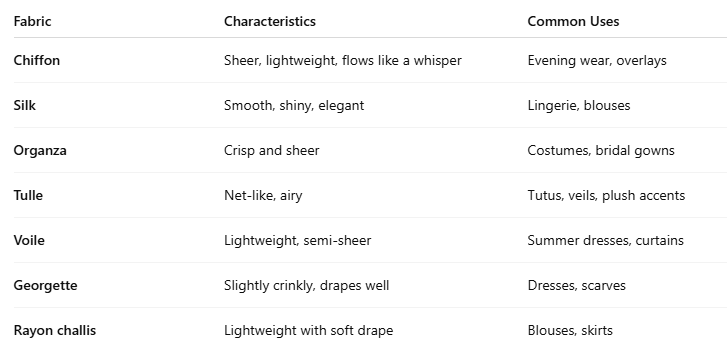✨ Sew Softly: A Complete Guide to Sewing with Delicate Fabrics
Ah, delicate fabrics — beautiful, dreamy, and just slippery enough to make you consider switching hobbies. But fear not! With the right tools, techniques, and a few tricks up your ruffled sleeve, sewing delicate fabrics like silk, chiffon, and tulle can be more sweet than stressful.
Whether you're making a floaty dress, a sheer blouse, or a magical plushie with fairy wings (because ✨why not✨), this guide has everything you need to handle even the most high-maintenance fabrics.
🧵 What Counts as a “Delicate Fabric”?
Delicate fabrics are lightweight, soft, often sheer or drapey, and prone to fraying, shifting, or puckering. They're gorgeous, but require some TLC.
✂️ Tools You’ll Love (and Need)
Here are some beginner-friendly (and stress-reducing) tools to keep things from slipping away — literally:
🧷 Best Supplies for Sewing Delicate Fabrics:
Microtex needles – Use a fine needle (size 60/8 or 70/10) to avoid snags and holes.
👉 Shop Microtex needles on AmazonLightweight thread – Use high-quality polyester or cotton thread for smooth seams.
👉 Shop Gutermann threadFine pins or clips – Glass head pins or sewing clips won’t leave holes or get lost in your layers.
👉 Buy extra-fine pinsWash-away tape – Stabilize seams without shifting layers. It’s magic in a roll!
👉 Get wash-away Wonder TapeWalking foot or Teflon foot – Helps feed the fabric evenly without stretching or dragging.
👉 Check out a walking foot attachmentRotary cutter and mat – Prevent fabric shifting during cutting. Scissors = slippery situations.
👉 Shop rotary cutter sets
🧵 How to Sew Delicate Fabrics Like a Pro
1. Pre-wash (if safe!)
Check if your fabric can be gently washed to remove chemicals and shrinkage surprises.
2. Use tissue paper or stabilizer
Place tissue paper under or between layers of fabric to prevent shifting or puckering. Tear it away afterward like a sewing superhero.
3. Reduce tension and pressure
Lower your presser foot pressure and test stitch settings on a scrap first.
4. Shorten your stitch length
Go with a fine stitch (2.0–2.5mm). Too long and your seams won’t hold; too short and your fabric may pucker.
5. No backstitching!
Backstitching can chew up fragile fabric. Tie off your thread ends instead.
6. Seam finishes matter
Avoid raw edges — delicate fabrics fray faster than you can say “help.” Try:
French seams for enclosed elegance.
Narrow rolled hems for that dreamy drape.
Bias tape binding for a clean edge (especially around curves).
💡 Bonus Tips for Delicate Drama Queens (ahem, fabrics)
Avoid fabric markers that might bleed. Use chalk or air-erasable pens.
Iron with care. Low heat and press cloths only — or you’ll end up with shiny regrets.
Cut one layer at a time. Fabric shifting is real. Go slow and steady.
Don’t tug! Let the machine feed it gently. You’re not in a tug-of-war with chiffon.
✨ Try It With:
A plush fairy wing made of tulle or organza
A vintage-inspired doll dress using voile or rayon challis
A delicate travel pouch using silk scraps
A flowy scarf or plush cape in chiffon
🧵 Final Thoughts
Delicate fabrics don’t have to be intimidating — just think of them as the divas of the sewing world. Demanding? Yes. But when treated right, they’ll give you stunning, floaty results that are totally worth the effort.
And remember: if all else fails, walk away, grab a cookie, and come back with fresh pins and determination. You’ve got this!
🛍️ Shop This Post
✂️ Related Posts
🔒 Affiliate Disclosure
This post contains affiliate links, which means I may earn a small commission if you purchase through them — at no extra cost to you! Thank you for supporting Sew Cute Patterns!

